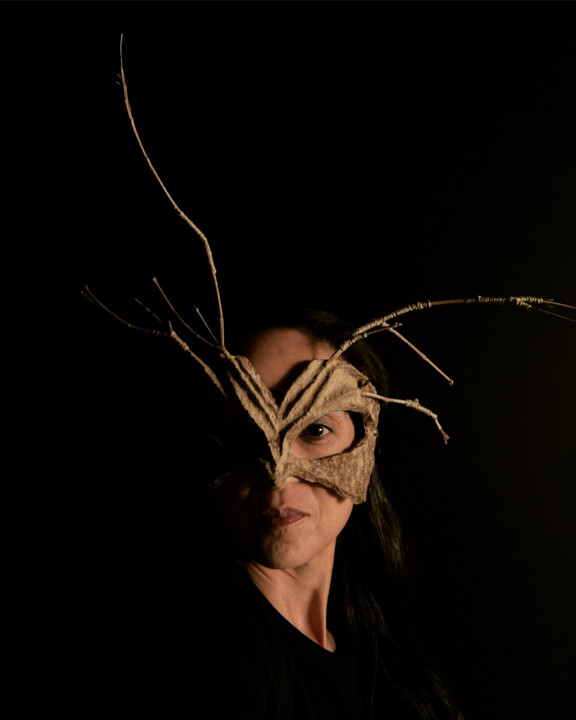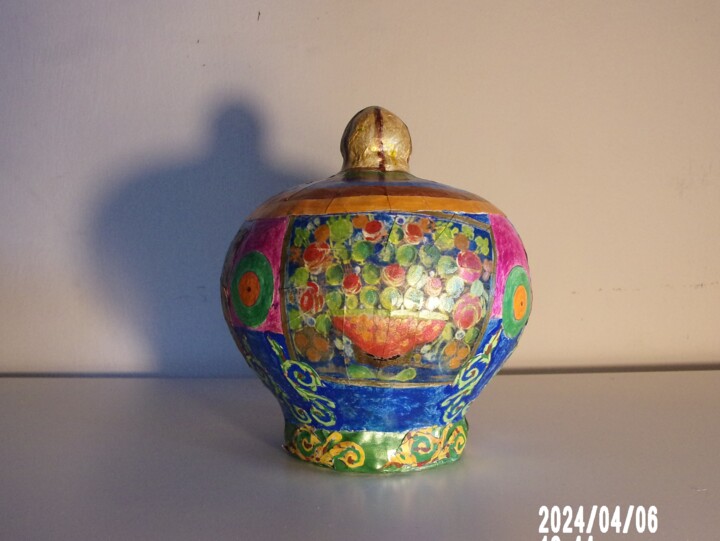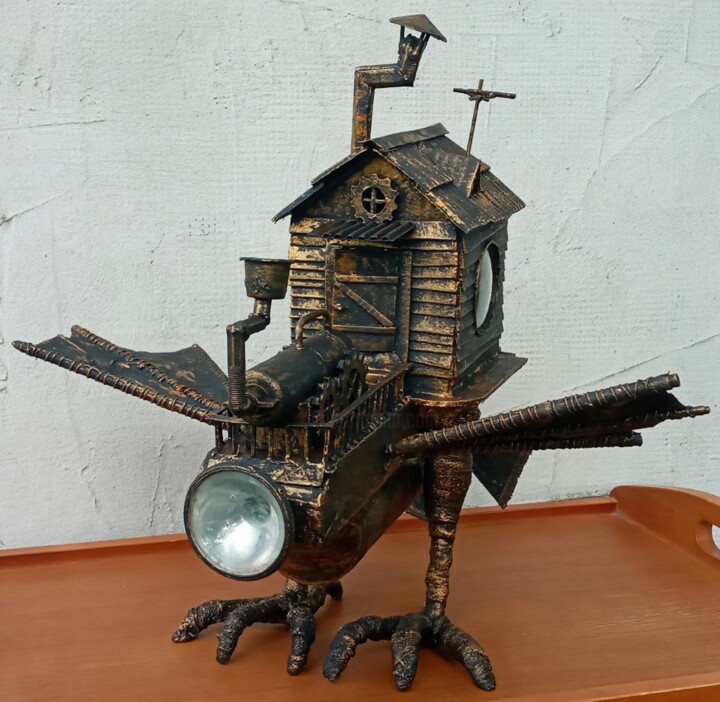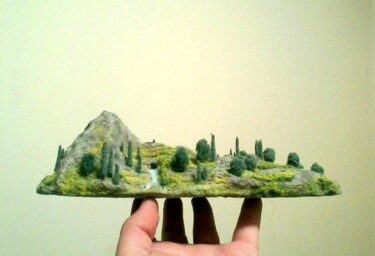4 Original Contemporary Sculptures For Sale:
How to define Land Art style?
Land art, also known as earth art, is created directly in the landscape by sculpting it or by building natural-material structures there. Land art was a protest against the "ruthless commercialization" of art in America throughout the 1960s and 1970s. However, photographic documentation was frequently displayed in conventional gallery spaces. During this time, proponents of land art rejected the museum or gallery as the setting for artistic activity and created monumental landscape projects that were outside the scope of traditional transportable sculpture and the commercial art market. Minimalist and conceptual art, as well as contemporary trends like De Stijl, Cubism, minimalism, and the works of Constantin Brâncuși and Joseph Beuys, served as inspiration for Land art.
The art movement's main concerns were its opposition to the commercialization of the arts and its enthusiasm for the newly emerging ecology movement. The prevalence of the anti-urban sentiment and its countervailing passion for country life coincided with the art movement. Spiritual aspirations for the Earth to serve as humanity's home were among these impulses.
A process-based method of creating art where the artist would go on excursions into the surrounding environment to either collect objects or carry out site-specific interventions quickly evolved from what had initially started as a trend in sculpture to incorporate natural materials like dirt, rocks, and plants. While some artists created temporary, limited interventions in the landscape, others used mechanical earthmoving equipment to create their earthworks. For presentation in galleries, artists frequently used photographs, films, and maps to document their earthworks. Additionally, by combining organic elements from the environment into sculptures and installations, land artists created land art in the galleries.
The first American museum to present an exhibition of Earth art, simply titled Earth Art, was the Herbert F. Johnson Museum of Art at Cornell University in February 1969. The artworks were on view at the museum as well as all over Cornell University's Ithaca campus, providing a venue for pieces that would later continue to challenge the status of art as a commodity, particularly those installations that blurred the lines between an object's context and its surroundings.
Land Art Sculpture
Through the materials they employed and the locations of their works, Land Artists explored the limits of art, frequently actively altering the landscape to create their sculptures and installations. These works of art were frequently carved directly from the earth or transformed into Earthwork art by the artist utilizing the available natural resources. The use of these elements honored the uniqueness of the location and included dirt, plants, rocks, gravel, stones, twigs, and water, which were often found on-site.
The Earth art that was produced introduced the idea of location specificity to the art world. Due to the fact that these works of art were not always accessible to visitors and that artists were occasionally the only people aware of their existence, these sculptures put artists at the center of their creations. As a result, artists frequently chronicle their work through photographs, which they subsequently use to display in place of their actual works at art galleries.
As the Land Art movement opposed the brutal commercialization of art throughout the 1960s, this change in setting challenged the notion that art exists solely as something to be observed. These works investigated a return to nature, which sparked the growth of the environmental movement that recognized Earth as the real home of humanity. As a result, Land artists started to create Earth art that glorified this ideal and showed a complete rejection of metropolitan life.
As the traditional places for artistic activity, museums and galleries, were abandoned, artists were given the opportunity to create monumental sculptures that were outside the scope of traditional transportable artworks. Land artists were compelled to rely on the system they hated to support their pricey ideas in order to produce sculptures and installations outside of conventional gallery and museum locations. Huge landscape installations frequently required the purchase of land and the use of earthmoving tools; wealthy patrons and private foundations frequently provided funds for these extravagant projects.
Land Art Sculptors
Robert Smithson (1938-1973)
American artist Robert Smithson was probably one of the most significant pioneers of this movement. As a response to Modernism's disengagement from social issues, his 1968 essay "The Sedimentation of the Mind: Earth Projects" offered a critical framework for the movement. In order to create three-dimensional sculptural compositions, he started combining various materials. This led to a series of "non-sites" works, in which sculptures made of earth and rocks that were brought back from expeditions were placed inside of galleries. These sculptures frequently included maps, bins, mirrors, glass, and neon. Smithson's earthworks Spiral Jetty (1970), Broken Circle/Spiral Hill (1971), and Amarillo Ramp (1973) are his most famous creations (1973). By completely removing art from the gallery context and integrating it into the natural terrain, he forever altered preconceived concepts of sculptural form in contemporary art.
Walter De Maria (1935-2013)
In his sculptures, installations, and land works, Walter de Maria employed geometric forms to produce a succession of repetitions that explored the link between the relative and the absolute. Lighting Field (1977), his best-known piece of land art, is a grid of one-mile by one-kilometer squares that was put in a remote part of the New Mexico desert. Four hundred poles made of polished stainless steel that are over twenty feet tall and have pointed tips that define a horizontal plane - the point of attraction for lightning strikes - make up the grid. The visitor can enter the grid physically or observe it from a distance, in a series of powerful optical illusions that vary with time and space, art, landscape, and nature collide.
Dennis Oppenheim (1938-2011)
Oppenheim's early interventions into the natural world, in contrast to those of many of his contemporaries, took the form of removal, going back to the traditional sculptural principle of carving by, in the artist's own words, "taking away rather than adding." Geopolitical boundaries, time zones, and natural degradation are only a few examples of the social and natural systems that are referenced and highlighted in Annual Rings (1968), a site-specific work. Reproducing the map serves to demonstrate how mapping plays a part in creating unnatural and frequently violent borders between states and the river, a natural border, serves as a tool for these international borders.
Oppenheim questioned "the relative values of the ordering systems by which we live" by juxtaposing natural elements with artificial ideas such as nationhood and time zones. At the same time, earth artists like Robert Smithson and Walter de Maria were also producing site-specific Earthworks where natural environments were put in conflict with artificial interventions.
Nancy Holt (1938 - 2014)
The public sculptures, installation art, and Land Art that Holt created throughout the course of her career are what are best known, along with some of her experimental video and photography. In order to carry on the inventive and curious spirit of both her and her husband's (Robert Smithson) works, Holt founded the Holt/Smithson Foundation in 2017. Through their sculptural practice, they created new approaches to explore our relationship to the world.
Richard Long (born 1945)
A well-known British sculptor involved with the Land Art movement was Richard Long. In the late 1960s, the artist began his direct interaction with nature by using his stroll as a medium, motivated by a desire to use the landscape in new ways. Long attempted to subvert the language and aspirations of art and bring it to a more basic, intimate, and fundamental level through a sequence of repetitive gestures or protracted solo walks. His goal was to exemplify in himself the possibilities of an unadulterated conversation between man and environment. Time, space, and distance are the subjects of this groundbreaking conceptual land art project, and they are expanded to a massive scale.
Andy Goldsworthy (born 1956)
Andy Goldsworthy is a well-known land art sculptor and photographer who works in and with nature. His output can be classified into permanent and temporary projects. The latter are designed to vanish at the end of the life cycle and are constructed from organic and transient components. He creates a number of repetitive designs, including spirals, circles, and snaking lines, out of branches, leaves, rocks, and ice. The ephemerality at the center of these initiatives is a reflection of a fragile ecology and a continually changing natural environment.
Discover contemporary Artworks on Artmajeur
Contemporary art is a vibrant constellation of artistic expressions. This creative universe encompasses a wide array of mediums, from paintings, sculpture, and photography to drawing, printmaking, textile art, and digital art, each medium a star shining with its own distinct radiance. Artists use diverse supports and materials to bring their visions to life, such as canvas, wood, metal, and even innovative digital canvases for the creation of virtual masterpieces.
A contemporary painting, for instance, may weave its story through the masterful strokes of acrylic or oil, while a contemporary sculpture might sing its song in the language of stone, bronze, or found objects. The photographic arts capture and manipulate light to produce striking images, while printmaking employs techniques like lithography and screen-printing to produce multiples of a single, impactful image. Textile art plays with fabrics and fibers, whereas digital art pushes the boundaries of creation with innovative technology.
The allure of contemporary art lies in its boundary-pushing nature, its relentless quest for experimentation and its constant reflection of the evolving human experience. This boundless creativity, coupled with its strong social and personal commentary, makes every piece of contemporary art a unique emblem of its time, a mirror held up to the realities and dreams of our complex world. It whispers to us, moves us, provokes thought, and kindles a deep emotional response, stirring the soul of anyone willing to listen. It is, indeed, the language of emotions and ideas, spoken in the dialect of our era.

©2023 Maria Larromana
Origins and history of contemporary art
The story of contemporary art unfolds in the mid-20th century, marked by seismic shifts in artistic expression. Post-World War II, around the 1950s and 1960s, artists began experimenting beyond traditional confines, challenging the norms of what art could be. This revolutionary epoch birthed myriad new movements and artistic forms such as abstract expressionism, pop art, and minimalism. Paintings, once confined by realism, embraced abstraction, as artists used color and form to express emotions and ideas. Notable periods like the advent of pop art in the late 1950s and early 1960s saw artworks mimicking popular culture and mass media, reflecting society’s shifting focus.
The sculptural arts, too, witnessed a metamorphosis. Sculptors started to experiment with new materials and forms, often creating artworks that interacted with the viewer and the surrounding space, fostering a sense of engagement. Drawing, a timeless practice, also evolved, with artists incorporating innovative techniques and concepts to redefine its role in contemporary art.
Photography, a relatively new medium, emerged as a powerful tool in the contemporary art landscape. Born in the 19th century, it truly came into its own in the latter half of the 20th century, blurring the lines between fine art and documentation. Printmaking, a practice dating back to ancient times, saw renewed interest and experimentation with techniques like lithography, etching, and screen printing gaining prominence.
The realm of textile art expanded dramatically, as artists began to appreciate the versatility and tactile quality of fabric and fibers. Artists began using textiles to challenge the boundaries between fine art, craft, and design.
The dawn of digital technology in the late 20th century heralded a new age for contemporary art. Digital art emerged as artists started leveraging new technologies to create immersive, interactive experiences, often blurring the line between the virtual and the physical world.
Through these transformative periods, the essence of contemporary art has remained the same: a dynamic, evolving reflection of the times we live in, continually pushing boundaries and embracing the new, always questioning, always exploring.

©2024 Enrico Marzi
Evolutions of theses contemporary works in the art market
As we navigate through the 21st century, the dynamic landscape of contemporary art continues to evolve and expand, reflecting our ever-changing world. Contemporary paintings, once primarily confined to two-dimensional canvases, now embrace a multitude of forms and techniques, ranging from mixed media installations to digital creations, each piece a rich a weaving of thoughts, emotions, and narratives. Sculpture, too, has ventured far beyond traditional stone and bronze, with artists incorporating light, sound, and even motion, embodying the ephemerality and flux of the modern world.
Photography, in the hands of Contemporary Artists, has expanded its horizons, seamlessly blending with digital technology to create breathtaking imagery that challenges our perception of reality. Drawing, as well, has transcended the borders of paper, incorporating multimedia elements and exploratory techniques to redefine its role in the artistic discourse. Printmaking continues to flourish, with contemporary artists using traditional methods in innovative ways to deliver potent social and personal commentaries.
Textile art, once considered a craft, now holds a prominent place in the contemporary art world, with artists using it to explore issues of identity, tradition, and cultural heritage. Meanwhile, digital art, the newest member of the contemporary art family, has revolutionized the way we create and interact with art, presenting immersive experiences that blur the boundary between the virtual and the physical.
These diverse forms of contemporary art hold significant value in the current art market, not only due to their aesthetic appeal but also their ability to encapsulate and communicate complex ideas and emotions. Collectors, curators, and art lovers worldwide seek these works, drawn to their inherent dynamism, their innovative use of materials, and their eloquent expressions of our shared human experience. As a testimonial to our times, these contemporary artworks encapsulate the pulse of our society and the resonance of individual voices, forever etching our collective narrative into the annals of art history.

©2020 Vasilios Alexiou
Famous Contemporary Artists
As we delve into the vibrant realm of contemporary art, we encounter an array of artists who shape this dynamic field. Each a master in their medium - painting, sculpture, photography, drawing, printmaking, textile, or digital art - they push artistic boundaries, reflecting our era and challenging perceptions. Let’s explore these remarkable contributors and their groundbreaking works.
1. Gerhard Richter - Known for his multi-faceted approach to painting, Richter challenges the boundaries of the medium, masterfully oscillating between abstract and photorealistic styles. His works, whether featuring squeegee-pulled pigments or blurred photographic images, engage in a fascinating dialogue with perception.
2. Jeff Koons - A significant figure in contemporary sculpture, Koons crafts monumental pieces that explore themes of consumerism, taste, and popular culture. His iconic balloon animals, constructed in mirror-polished stainless steel, captivate with their playful yet profound commentary.
3. Cindy Sherman - An acclaimed photographer, Sherman uses her lens to explore identity and societal roles, particularly of women. Renowned for her conceptual self-portraits, she assumes myriad characters, pushing the boundaries of photography as a medium of artistic expression.
4. David Hockney - Hockney, with his prolific output spanning six decades, is a pivotal figure in contemporary drawing. His bold use of color and playful exploration of perspective convey an intoxicating sense of joy and an unabashed celebration of life.
5. Kiki Smith - An innovative printmaker, Smith’s work explores the human condition, particularly the female body and its social and cultural connotations. Her etchings and lithographs speak to universal experiences of life, death, and transformation.
6. El Anatsui - A master of textile art, Anatsui creates stunning tapestry-like installations from discarded bottle caps and aluminum scraps. These shimmering, flexible sculptures blend traditional African aesthetic with contemporary art sensibilities, speaking to themes of consumption, waste, and the interconnectedness of our world.
7. Rafael Lozano-Hemmer - A leading figure in digital art, Lozano-Hemmer utilizes technology to create interactive installations that blend architecture and performance art. His work, often participatory in nature, explores themes of surveillance, privacy, and the relationship between people and their environments.

©2022 Steampunker_ukraine
Notable contemporary artworks
The contemporary art landscape is a dynamic patchwork of diverse expressions and groundbreaking ideas, each artwork a unique dialog with its audience. Here are a selection of some renowned contemporary artworks, spanning various media such as painting, sculpture, photography, drawing, printmaking, textile art, and digital art, that have profoundly influenced this vibrant movement.
"Cloud Gate" by Anish Kapoor, 2006 - This monumental stainless steel sculpture, also known as "The Bean," mirrors and distorts the Chicago skyline and onlookers in its seamless, liquid-like surface, creating an interactive experience that blurs the line between the artwork and the viewer.
"Marilyn Diptych" by Andy Warhol, 1962 - An iconic piece of pop art, this silkscreen painting features fifty images of Marilyn Monroe. Half brightly colored, half in black and white, it reflects the dichotomy of celebrity life and its influence on popular culture.
"Rhein II" by Andreas Gursky, 1999 - This photographic artwork, a digitally-altered image of the Rhine River, is celebrated for its minimalist aesthetic. It strips the landscape to its bare essentials, invoking a sense of tranquility and vastness.
"Black Square" by Kazimir Malevich, 1915 - A revolutionary painting in the realm of abstract art, this piece, featuring nothing more than a black square on a white field, challenges traditional notions of representation, symbolizing a new era in artistic expression.
"Puppy" by Jeff Koons, 1992 - This giant sculpture, a West Highland Terrier blanketed in flowering plants, explores themes of innocence, consumer culture, and the interplay between high art and kitsch. It’s a delightful blend of traditional sculpture and garden craft.
"Re-projection: Hoerengracht" by Ed and Nancy Kienholz, 1983-1988 - A room-sized tableau representing Amsterdam’s red-light district, this work combines elements of sculpture, painting, lighting, and found objects. It engages viewers in a stark commentary on commodification and objectification.
"Untitled" (Your body is a battleground) by Barbara Kruger, 1989 - This photomontage, combining black-and-white photography with impactful text, explores issues of feminism, identity, and power. Its potent, confrontational message is a prime example of the power of text in contemporary visual art.
"For the Love of God" by Damien Hirst, 2007 - This sculpture, a platinum cast of a human skull encrusted with 8,601 diamonds, probes themes of mortality, value, and the human fascination with luxury and decadence. It’s a compelling blend of macabre and magnificence.
"Physical impossibility of Death in the Mind of Someone Living" by Damien Hirst, 1991 - This artwork, featuring a tiger shark preserved in formaldehyde, blurs the line between traditional sculpture and biological specimen. It prompts viewers to contemplate mortality and nature’s ferocity.
"One and Three Chairs" by Joseph Kosuth, 1965 - A piece of conceptual art, it presents a physical chair, a photograph of a chair, and a dictionary definition of a chair, thus exploring the relationship between language, picture, and referent in art.
These pieces, in their diversity, exemplify the rich tapestry of contemporary art, each piece a unique commentary on our world and a testament to the limitless potential of creative expression.




